The SimCenter has developed the course modules below for use in your course curriculums. Included in each module are: the target audience, learning objectives, research tools involved, class materials, instructions to instructors, and contacts for questions. We are here to support you.
Please contact nheri-simcenter@berkeley.edu if you have further questions or inquiries.
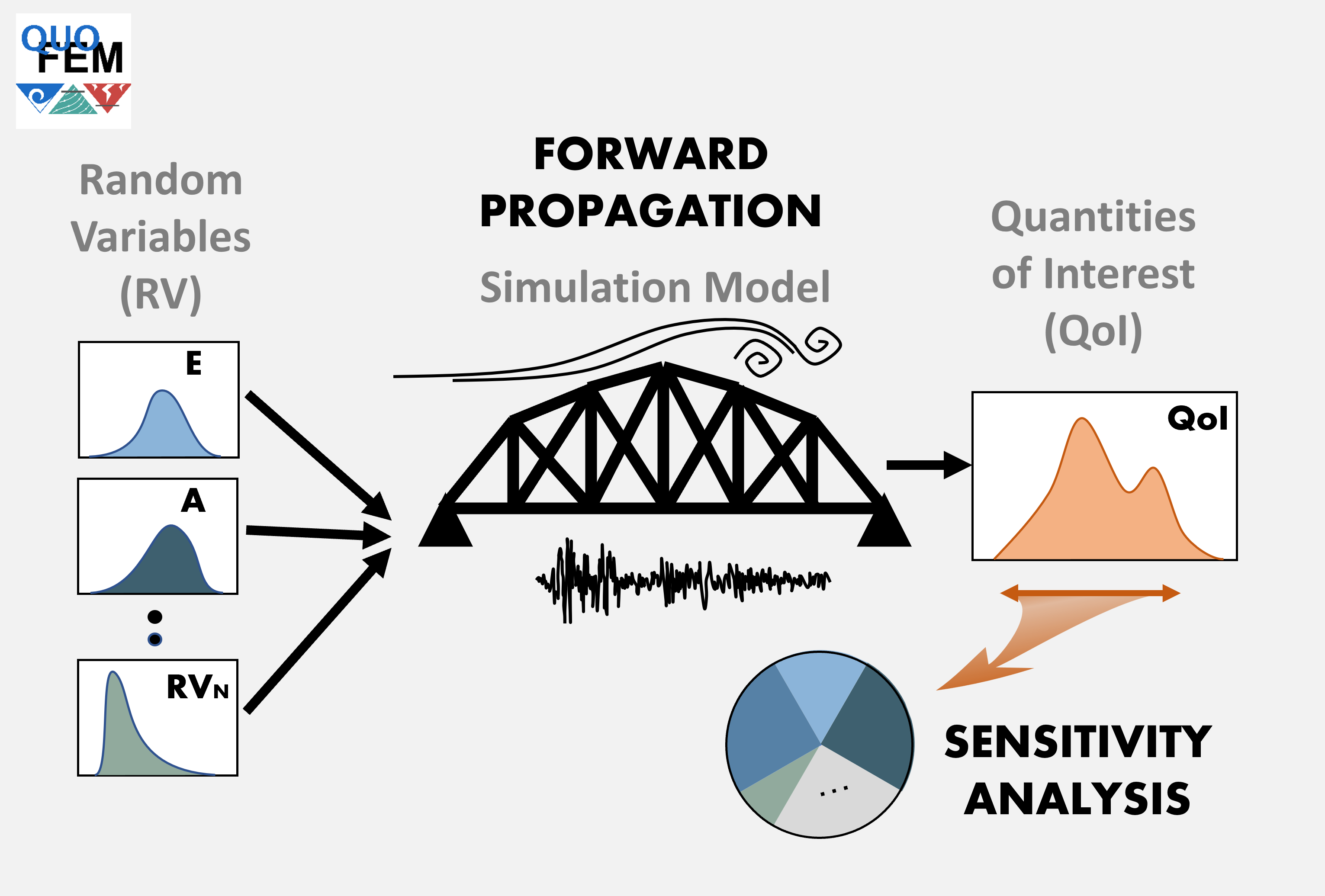
NOTE: This content is one of the topics in the UQ educational module series. UQ educational modules provide single-topic-focused lectures that can be plugged into an existing engineering course. Either SimCenter personnel can give lectures as guest lecturers or assist the instructors in developing tailored course materials. Other available topics include Bayesian updating, adaptive design of experiments in global surrogate modeling, and Bayesian model selection.
This course module provides an introduction to Global Sensitivity Analysis (GSA). Unlike local sensitivity analysis, where the variability of output is explored around a specific reference parameter value, GSA aims to evaluate the overall importance of each parameter in an engineering system by taking the full input space into account. Identification of the important parameters as well as the screening of trivial parameters is a fundamental task to any engineering analysis. Further, GSA can serve as a useful pre-analysis step to reduce the computational efforts in the main analysis, such as system optimization, system identification, model updating, and uncertainty analysis.
Target Audience: Graduate-level classes
NOTE: The contents and examples will be tailored to fit the level of each class. The materials for Target class 1 are designed to convey the concepts without UQ backgrounds. Therefore, the students do not require an understanding of random variables, probability density functions, or other UQ theories. Target class 2 will focus more on the UQ point of view both in theory (algorithms) and applications.
Learning Objectives:
Tools Involved:
Example class materials for Target Class 1:
Example class materials for Target Class 2:
Instructions for Instructors:
Contributors
Sang-ri Yi, UC Berkeley
Alexandros Taflanidis, University of Notre Dame
Ziqi Wang, UC Berkeley
Contact
Sang-ri Yi
Last Updated: February, 2023
Course questions: simcenter_education@berkeley.edu
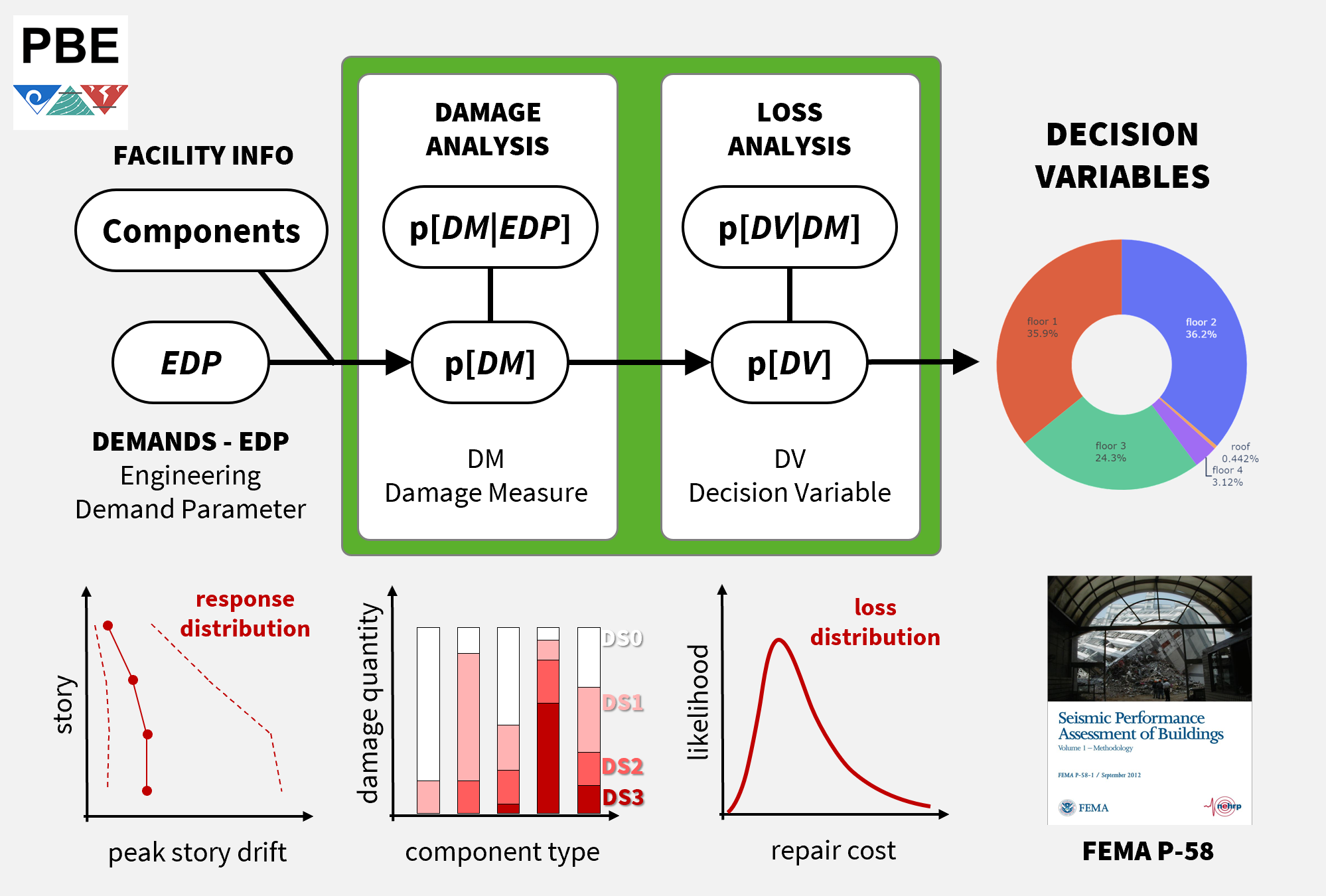
This assignment provides a high-level introduction to FEMA P-58 to structural engineering students. The starter package includes the performance model and demand data for the analysis of a 12-story reinforced concrete shear wall building at three intensities of ground shaking.
Students can use the SimCenter PBE Application to calculate the expected damages in the building and the consequences of those damages. The assignment has students process the results and guides them through the kinds of questions they can answer with this type of high-resolution analysis.
Target Audience:
Graduate students in Structural Engineering with basic knowledge of probabilities, earthquake engineering, and performance-based engineering.
Learning Objectives:
Tools Involved:
Introduction to FEMA P-58 Seismic Performance Assessment Course Materials:
Starter Package (Files needed to complete the homework assignment) (zip file)
Instructions for Instructors or TAs:
Introduction to SimCenter PBE
Describes: i) how to download the files for the assignment; ii) how to load the inputs; iii) how to run the analysis iv) how to find the results in the working directory; and v) how to interpret the results. (Powerpoint)
Contributors
Adam Zsarnóczay, Stanford University
Contact
Adam Zsarnóczay
Last updated: February, 2023
Course questions: simcenter_education@berkeley
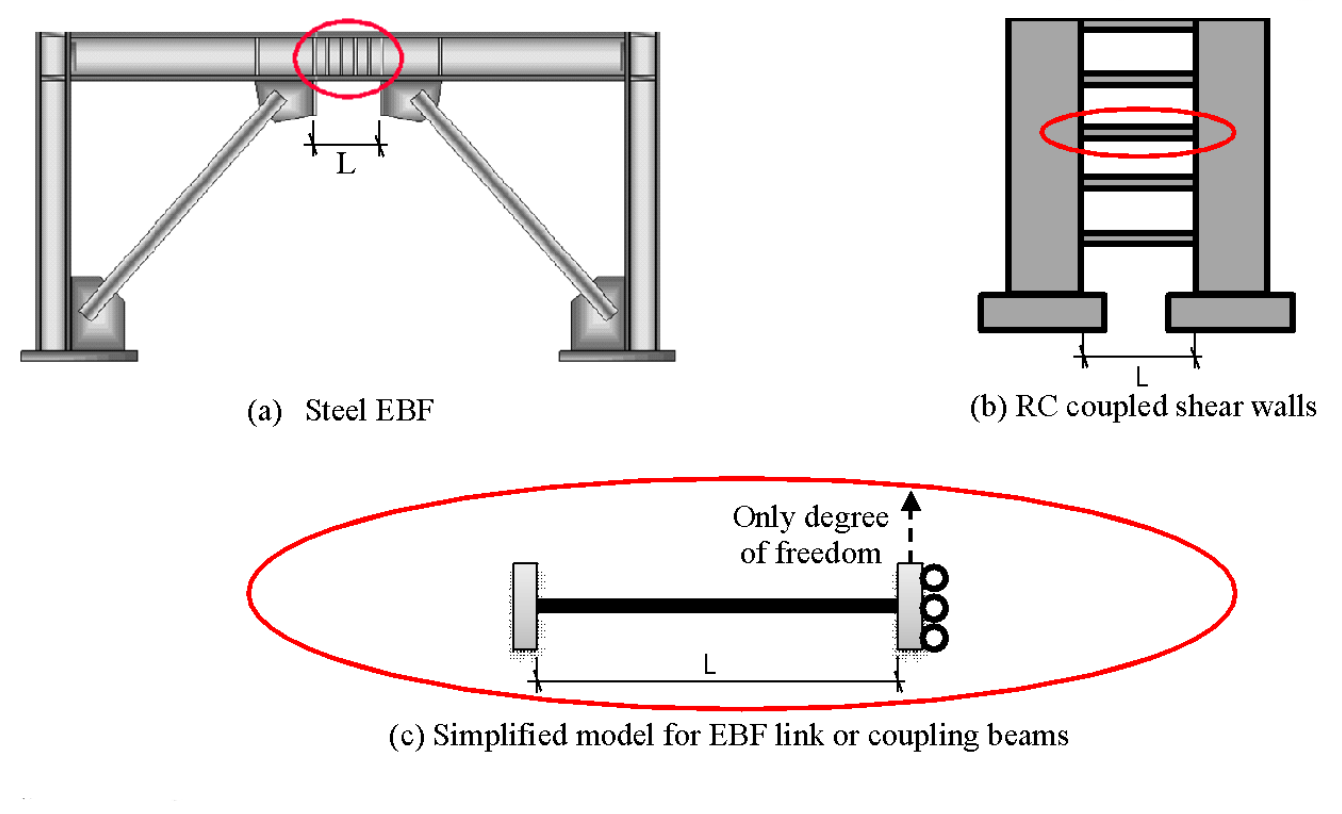 This module introduces OpenSeesPy for nonlinear analysis of structures using notebook scripting. The module prompts the student to simulate the nonlinear response of a single-degree-of-freedom structural member using three different nonlinear models: (1) plastic hinge model, (2) fiber-section lumped plasticity model, and (3) distributed plasticity model. Through this module, students familiarize themselves with OpenSeesPy and notebook scripting and develop an understanding of the capabilities and limitations of each modeling approach.
This module introduces OpenSeesPy for nonlinear analysis of structures using notebook scripting. The module prompts the student to simulate the nonlinear response of a single-degree-of-freedom structural member using three different nonlinear models: (1) plastic hinge model, (2) fiber-section lumped plasticity model, and (3) distributed plasticity model. Through this module, students familiarize themselves with OpenSeesPy and notebook scripting and develop an understanding of the capabilities and limitations of each modeling approach.
Target Audience:
Graduate students in Structural Engineering with basic knowledge of programing, linear and nonlinear structural analysis.
Learning Objectives:
Tools Involved:
Supplemental material:
Documents:
Instructions for Instructors or TAs: Please contact us if you need assistance using this module in your course or are interested in collaborating to develop new course materials.
Contributors
Greg Deierlein, SimCenter co-Director, Stanford University
Francisco Galvis, Project Engineer, Thornton Tomasetti
Contact
Francisco Galvis
Last updated: February, 2023
Course questions: simcenter_education@berkeley.edu
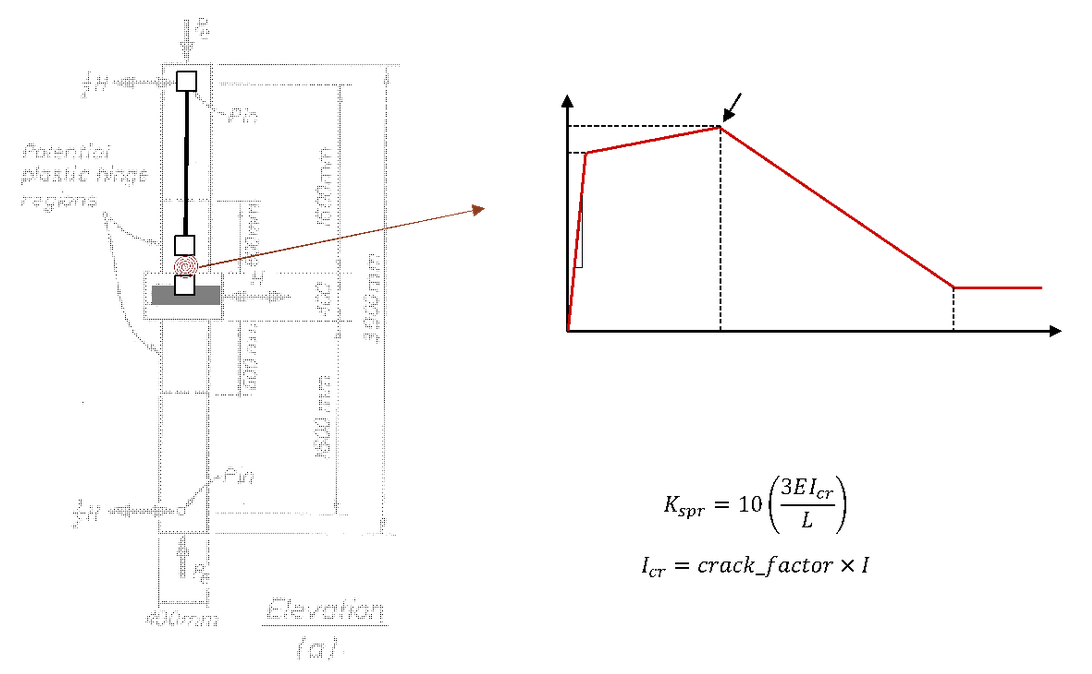 This module addresses the different questions that arise while calibrating a nonlinear structural model using experimental results. To this end, the students will use quoFEM to calibrate a concentrated plastic hinge model in OpenSeesPy of a rectangular concrete column tested by Soesianawati et al. (1989). The module guides the students in the execution of a parametric study, a deterministic calibration, and a Bayesian calibration or the parameters of the chosen model.
This module addresses the different questions that arise while calibrating a nonlinear structural model using experimental results. To this end, the students will use quoFEM to calibrate a concentrated plastic hinge model in OpenSeesPy of a rectangular concrete column tested by Soesianawati et al. (1989). The module guides the students in the execution of a parametric study, a deterministic calibration, and a Bayesian calibration or the parameters of the chosen model.
Target Audience:
Graduate students in Structural Engineering with basic knowledge of programing, linear and nonlinear structural analysis.
Learning Objectives:
Tools Involved:
Supplemental material:
Documents:
Instructions for Instructors or TAs: Please contact us if you need assistance using this module in your course or are interested in collaborating to develop new course materials. The completed answer sheet and code is available from the instructor.
Contributors
Greg Deierlein, SimCenter co-Director, Stanford University
Francisco Galvis, Project Engineer, Thornton Tomasetti
Adam Zsarnóczay, Stanford University
Contact
Francisco Galvis
Adam Zsarnóczay
Last updated: February, 2023
Course questions: simcenter_education@berkeley.edu
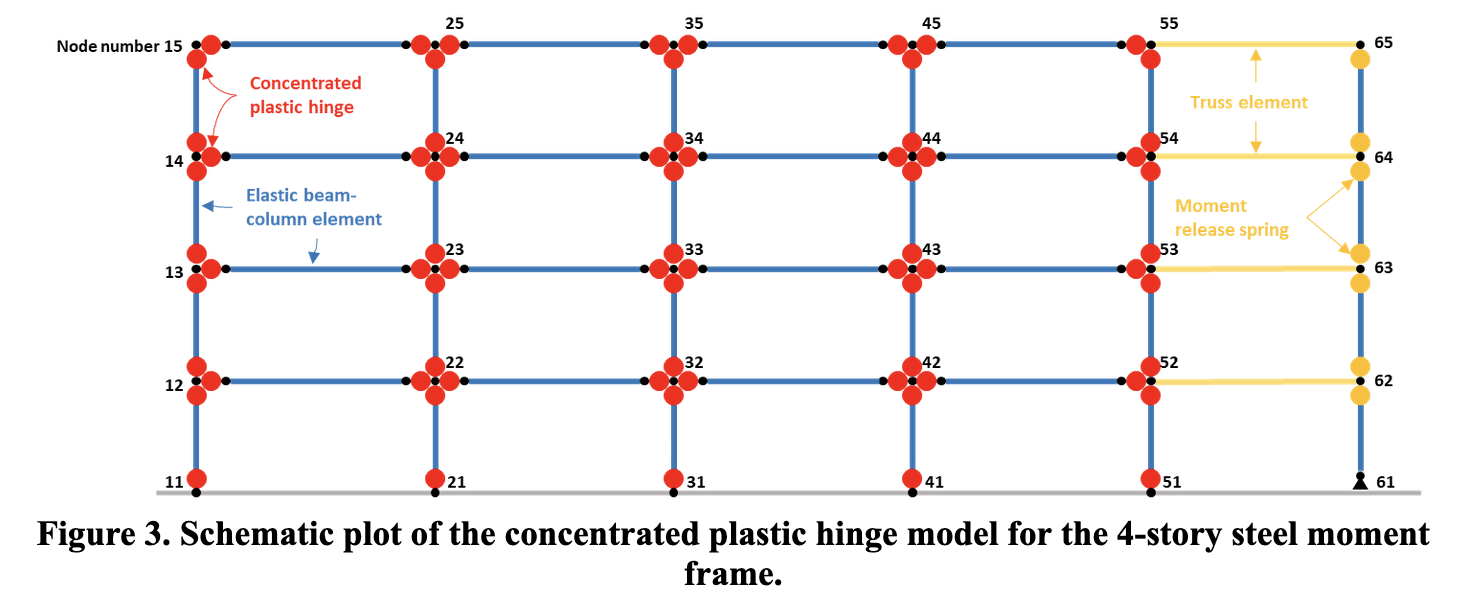 This module shows how to use quoFEM to perform forward uncertainty propagation of modeling parameters in a nonlinear static analysis (pushover) of a 4-story building. The building in this module is simulated in OpenSees tcl interpreter to expose the students to this alternative approach for structural simulations with OpenSees. The student will evaluate the seismic performance of this frame following the ASCE/SEI 41 provisions, quantify the uncertainty in the pushover curve for different scopes of the experimental campaign to collect data of the frame, and provide a final recommendation of the experimental campaign scope.
This module shows how to use quoFEM to perform forward uncertainty propagation of modeling parameters in a nonlinear static analysis (pushover) of a 4-story building. The building in this module is simulated in OpenSees tcl interpreter to expose the students to this alternative approach for structural simulations with OpenSees. The student will evaluate the seismic performance of this frame following the ASCE/SEI 41 provisions, quantify the uncertainty in the pushover curve for different scopes of the experimental campaign to collect data of the frame, and provide a final recommendation of the experimental campaign scope.
Target Audience:
Graduate students in Structural Engineering with basic knowledge of programing, linear and nonlinear structural analysis.
Learning Objectives:
Tools Involved:
Supplemental material:
Documents:
Instructions for Instructors or TAs: Please contact us if you need assistance using this module in your course or are interested in collaborating to develop new course materials. The completed answer sheet and code is available from the instructor.
Contributors
Greg Deierlein, SimCenter co-Director, Stanford University
Francisco Galvis, Project Engineer, Thornton Tomasetti
Contact
Francisco Galvis
Last updated: February, 2023
Course questions: simcenter_education@berkeley.edu
 This module introduces EE-UQ as a tool to perform nonlinear response history analyses (NLRHA) of structures using the same 4-story building in the Uncertainty in Nonlinear Static Analysis of Structures Module. The students will select ground motions to match a target spectrum and perform NLRHA using the high-performance computing resources at DesignSafe. Finally, the students will have the opportunity to interpret the response of the frame based on the NLRHA results.
This module introduces EE-UQ as a tool to perform nonlinear response history analyses (NLRHA) of structures using the same 4-story building in the Uncertainty in Nonlinear Static Analysis of Structures Module. The students will select ground motions to match a target spectrum and perform NLRHA using the high-performance computing resources at DesignSafe. Finally, the students will have the opportunity to interpret the response of the frame based on the NLRHA results.
Target Audience:
Graduate students in Structural Engineering with basic knowledge of programing, linear and nonlinear structural analysis.
Learning Objectives:
Tools Involved:
Supplemental material:
Documents:
Instructions for Instructors or TAs: Please contact us if you need assistance using this module in your course or are interested in collaborating to develop new course materials. The completed answer sheet and code is available from the instructor.
Contributors
Greg Deierlein, SimCenter co-Director, Stanford University
Francisco Galvis, Project Engineer, Thornton Tomasetti
Kuanshi Zhong, Assistant Professor, University of Cincinnati
Contact
Francisco Galvis
Kuanshi Zhong
Last updated: February, 2023
Course questions: simcenter_education@berkeley.edu
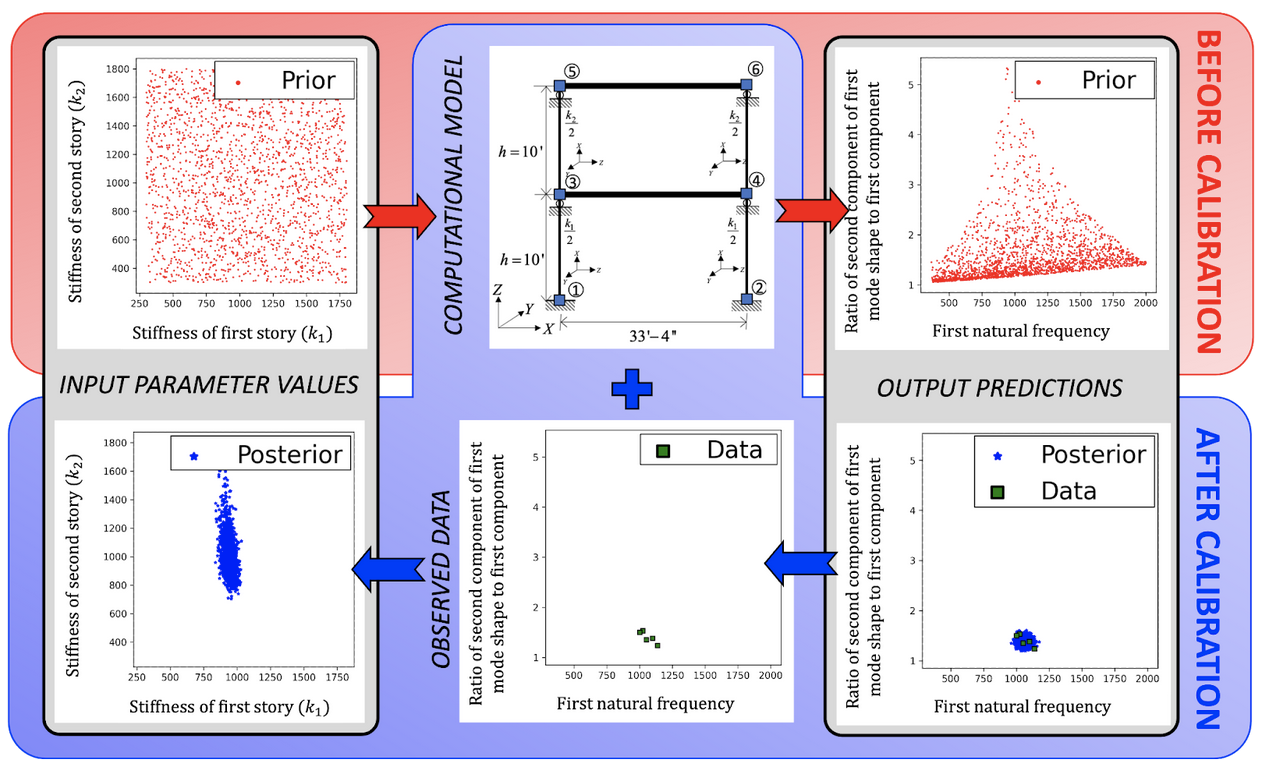
This module provides an introduction to i) Bayesian updating for model calibration and quantification of the uncertainty in estimated model parameters and ii) the use of the SimCenter’s quoFEM tool to solve this computational problem.
Target Audience:
Graduate students and upper-level undergraduate students interested in solving system identification, parameter identification, reliability analysis, risk analysis, and model calibration and validation problems, where model updating based on data is important or required.
Learning Objectives:
Tools Involved:
Supplemental material:
Documents:
Instructions for Instructors or TAs: Please contact us if you need assistance using this module in your course or are interested in collaborating to develop new course materials. The completed answer sheet and code is available from the instructor.
Contributors
Aakash Bangalore Satish, UC Berkeley
Joel P. Conte, UC Berkeley
Contact
Aakash Bangalore Satish
Last Updated: April, 2024
Course questions: simcenter_education@berkeley.edu
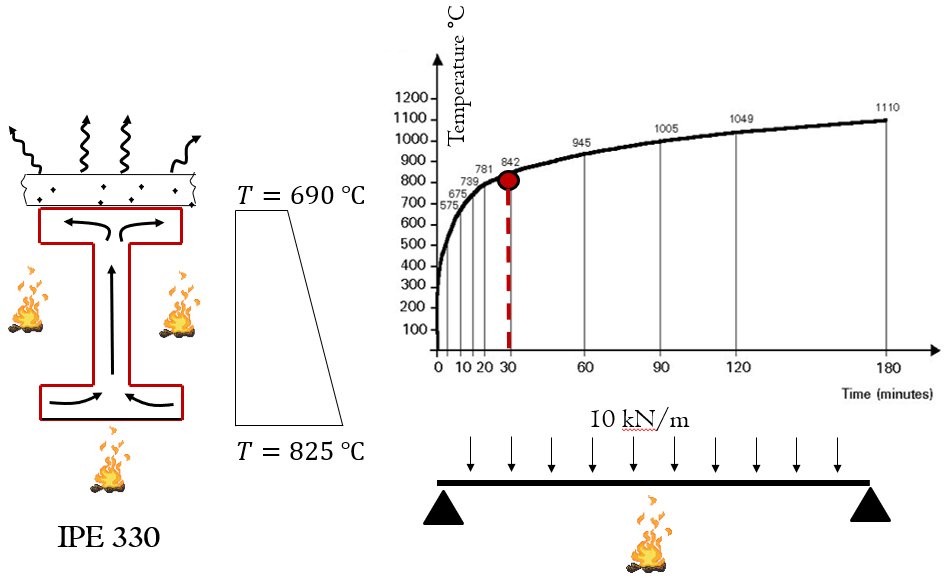
This module provides an introduction to the performance-based structural fire engineering with an isolated structural member. The starter package uses OpenSeesPy to simulate the thermo-mechanical response of a horizontal structural member subjected to both gravity load and ASTM E119 Standard fire temperatures for up to 30 minutes. Through this module, the students observe the effect of (1) boundary restraints, (2) gravity loading, (3) mesh refinement on the structural fire response.
Target Audience:
Graduate students in Structural and Mechanical Engineering with basic knowledge of programing, linear and nonlinear thermo-mechanical structural analysis, and heat transfer.
Learning Objectives:
List of Tools:
Supplemental material:
Documents:
Instructions for Instructors or TAs: Please contact us if you need assistance using this module in your course or are interested in collaborating to develop new course materials. The completed answer sheet and code is available from the instructor.
Contributors
Serdar Selamet, Stanford University
Contact
Serdar Selamet
Last Updated: November, 2024
Course questions: simcenter_education@berkeley.edu
This webinar provides an overview of SimCenter software applications, teaching modules, and related resources to facilitate the use of advanced computational tools in engineering education. The focus is on applications that have been used in graduate courses in nonlinear structural analysis, performance-based earthquake engineering, geotechnical engineering, and regional earthquake risk analysis.